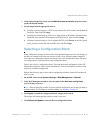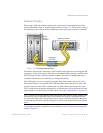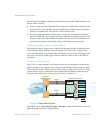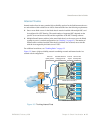
SmartConnect User’s Guide
BMD00082, February 2009 Chapter 3: Switch Virtualization
31
External Trunks
When using a VSG with multiple external ports, a trunk can be created between the switch
module and another switch. A simple example is shown in Figure 3-A. This provides a virtual
link operating at up to 30G per second, depending on how many physical ports are combined.
Figure 3-A Trunking External Ports
The trunk is also useful for connecting a switch module to third-party devices that support link
aggregation, such as Cisco routers and switches with EtherChannel technology (not ISL trunk-
ing technology) and Sun's Quad Fast Ethernet Adapter. The switch’s trunking technology is
compatible with these devices when they are configured manually.
Each VSG can have up to two external port trunks. Each of these trunks may consist of as
many external ports as are available in the VSG. By default, the external ports for each VSG
are placed into one of the VSG’s available trunks. If all the switch ports belong to the same
VSG (as with the factory default configuration), all external ports will be placed into the same
trunk, though it is possible that not all links will be active (see “Trunking Rules” on page 32).
Note – Because all external ports in a VSG belong to the same trunk by default, external ports
should not be used as regular IEEE 802.3 network links. Do not plug a workstation directly
into one of the switch’s active external ports unless it is the only device attached to these ports,
or unless the port has been explicitly assigned to a VSG or trunk with no other active external
ports.
To reconfigure the trunk assignment for each external port, see “Virtual Switch Groups Mem-
bership” on page 97.
Blade
Server
Chassis
Switch
Module
Application Switch
Aggregate
Port Trunk


















